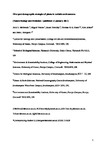Divergent demographic strategies of plants in variable environments
| dc.contributor.author | McDonald, JL | |
| dc.contributor.author | Franco, Miguel | |
| dc.contributor.author | Townley, S | |
| dc.contributor.author | Ezard, THG | |
| dc.contributor.author | Jelbert, K | |
| dc.contributor.author | Hodgson, DJ | |
| dc.date.accessioned | 2017-03-08T17:35:09Z | |
| dc.date.available | 2017-03-08T17:35:09Z | |
| dc.date.issued | 2017-01-13 | |
| dc.identifier.issn | 2397-334X | |
| dc.identifier.issn | 2397-334X | |
| dc.identifier.other | 29 | |
| dc.identifier.uri | http://hdl.handle.net/10026.1/8602 | |
| dc.description.abstract |
One of the best-supported patterns in life history evolution is that organisms cope with environmental fluctuations by buffering their most important vital rates against them. This demographic buffering hypothesis is evidenced by a tendency for temporal variation in rates of survival and reproduction to correlate negatively with their contribution to fitness. Here, we show that widespread evidence for demographic buffering can be artefactual, resulting from natural relationships between the mean and variance of vital rates. Following statistical scaling, we find no significant tendency for plant life histories to be buffered demographically. Instead, some species are buffered, whereas others have labile life histories with higher temporal variation in their more important vital rates. We find phylogenetic signal in the strength and direction of variance–importance correlations, suggesting that clades of plants are prone to being either buffered or labile. Species with simple life histories are more likely to be demographically labile. Our results suggest important evolutionary nuances in how species deal with environmental fluctuations. | |
| dc.format.extent | 0-0 | |
| dc.format.medium | Electronic | |
| dc.language | en | |
| dc.language.iso | en | |
| dc.publisher | Springer Science and Business Media LLC | |
| dc.subject | 0602 Ecology | |
| dc.subject | 0604 Genetics | |
| dc.subject | 0603 Evolutionary Biology | |
| dc.title | Divergent demographic strategies of plants in variable environments | |
| dc.type | journal-article | |
| dc.type | Journal Article | |
| plymouth.author-url | https://www.webofscience.com/api/gateway?GWVersion=2&SrcApp=PARTNER_APP&SrcAuth=LinksAMR&KeyUT=WOS:000417169600010&DestLinkType=FullRecord&DestApp=ALL_WOS&UsrCustomerID=11bb513d99f797142bcfeffcc58ea008 | |
| plymouth.issue | 2 | |
| plymouth.volume | 1 | |
| plymouth.publication-status | Published | |
| plymouth.journal | Nature Ecology & Evolution | |
| dc.identifier.doi | 10.1038/s41559-016-0029 | |
| plymouth.organisational-group | /Plymouth | |
| plymouth.organisational-group | /Plymouth/Faculty of Science and Engineering | |
| plymouth.organisational-group | /Plymouth/REF 2021 Researchers by UoA | |
| plymouth.organisational-group | /Plymouth/REF 2021 Researchers by UoA/UoA06 Agriculture, Veterinary and Food Science | |
| dc.publisher.place | England | |
| dcterms.dateAccepted | 2016-11-10 | |
| dc.rights.embargodate | 2017-7-13 | |
| dc.identifier.eissn | 2397-334X | |
| dc.rights.embargoperiod | No embargo | |
| rioxxterms.versionofrecord | 10.1038/s41559-016-0029 | |
| rioxxterms.licenseref.uri | http://www.rioxx.net/licenses/all-rights-reserved | |
| rioxxterms.licenseref.startdate | 2017-01-13 | |
| rioxxterms.type | Journal Article/Review |


